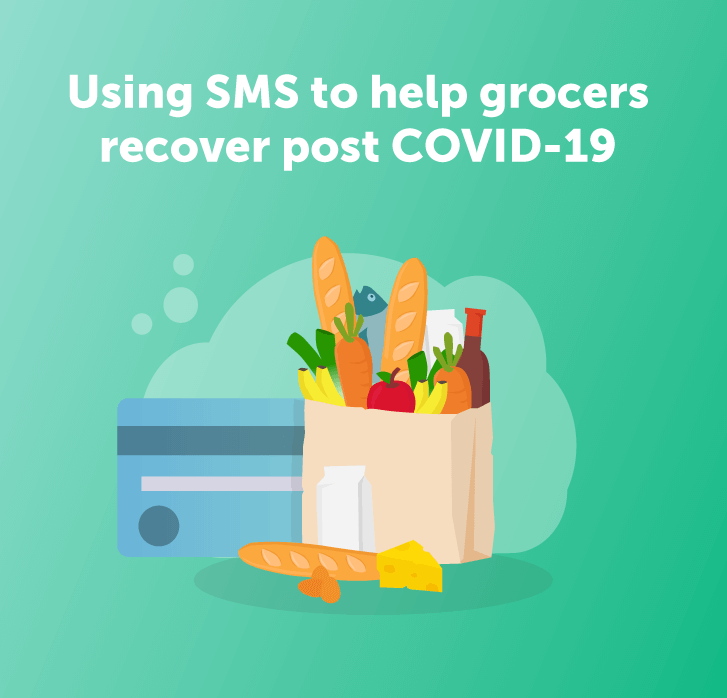The coronavirus outbreak has undoubtedly had a major impact on British retailers, with consumer behaviour quickly changing to adapt to the new rules and regulations introduced by the UK government.
According to the Financial Times the impact on the economy of Covid-19 was undeniable, with retail sales and business activity contracting at a record pace. In fact, the volume of British retail sales dropped 5.1% in March, the largest ever drop recorded by ONS. However, it wasn’t retail as a whole that suffered substantial losses in customer demand; grocery retailers experienced a 10.4% surge in business.
While this is encouraging news for grocery retailers and consequently their suppliers, this level of demand is unlikely to naturally remain stable once lockdown has lifted. Consequently, it is important to start considering how grocery retailers can communicate with their customers and encourage them to continue to shop in a similar fashion. How can they use the trends witnessed over the last few weeks to build and sustain demand post lockdown? How will consumer behaviour change and what can retailers do to ensure business remains stable?
Below we take a look at a couple of emerging trends in the retail industry during this period of isolation.

New routes to customers
A trend witnessed in the UK grocery retail market during lockdown is the further emphasis on B2B2C (Business to Business to Consumer), offering new routes to reach customers for retailers.
With Amazon quickly growing its share of the delivery market in the UK, there’s no surprise that grocery retailers are choosing to align themselves with the retail giant, as a means to expand their product reach. This concept was first noticed in 2017 when Morrisons formed an alliance with Amazon, to reach a larger portion of the British population and offer a substantially more competitive delivery timescale, in some cases offering same day delivery. However, since the outbreak of Covid-19, the Morrisons/Amazon alliance has strengthened further, with Amazon delivering a broader range of Morrisons products to a wider range of cities throughout the UK.
A smart move by Morrisons, who in 2017 experienced a 1.9% fall in like for like sales. Growing and organising a nationwide delivery service is costly and likely to take a great deal of time and energy to set-up. By merging forces with Amazon, Morrisons are able to compete in a way that has never before been possible, making their business more stable and becoming stronger competitors in the online grocery marketplace. This is a true growth area in grocery retail that is predicted to stay around for the foreseeable future.
A question that needs to be considered for all grocery retailers is whether or not they could sustain this same level of service, should the demand for home delivery continue?
Recommendation: Divert a portion of existing budget to support your home delivery operations and ensure you can provide increasingly competitive delivery time slots.
Role of communication: Delivery updates: Grocery shopping has moved drastically towards a quick and efficient online process. Ensure your customer communication reflects this new behaviour. We recommend sending SMS order confirmations and delivery updates that keep your customers informed.
Online retail and consumer behaviour
During lockdown we witnessed a surge in online food shopping with customers preferring a low contact approach to buying their groceries. The latest figures from grocery analysts Kantar show shoppers spent £524m more on groceries year on year in April, despite the fact that the number of supermarket visits dropped sharply.
This increase is to be expected with consumers looking to move their shopping online, however another element at play here is a change in consumer behaviour. According to The Guardian, the big weekly shop has made a comeback with supermarkets reporting record high orders as Britons develop new lockdown routines. This move towards one big weekly shop instead of smaller daily supermarket visits, is a step away from the UK’s shopping trends pre-Covid-19.
It was recorded in 2017 that two-thirds of Britons nipped to a supermarket more than once a day, and one in 10 people decided what to buy for an evening meal just moments before they ate it. However, while lockdown restrictions may look to be easing in the coming weeks, indications from China report that the big weekly shop is still showing dominance over smaller daily trips and most of the customer demand still comes from online orders.
Recommendation: Adapt your communication strategy to support this trend towards the big weekly shop. Perhaps provide guidance on meal planning, recipe inspiration or partner with a leading nutritionist or chef to help build your brand to become true foodie influencers rather than purely a grocery supplier.
Role of communication: Send an SMS Survey to your customer base to understand their eating habits; dietary restrictions, cooking ability & interest and discover any trends or meal inspiration that would be of interest to them. The information gained can then be used to inform your new communication strategy.
There is no denying that once the country moves from crisis to recovery, the shopping habits of the nation will once again change. However, by acting now and adapting your approach to these changes in consumer behaviour, you can ensure that you’re able to maintain high levels of demand far beyond the point that lockdown is lifted.
For more information on how we can help support your communication simply call 0117 205 0202 or email info@textmarketer.co.uk
